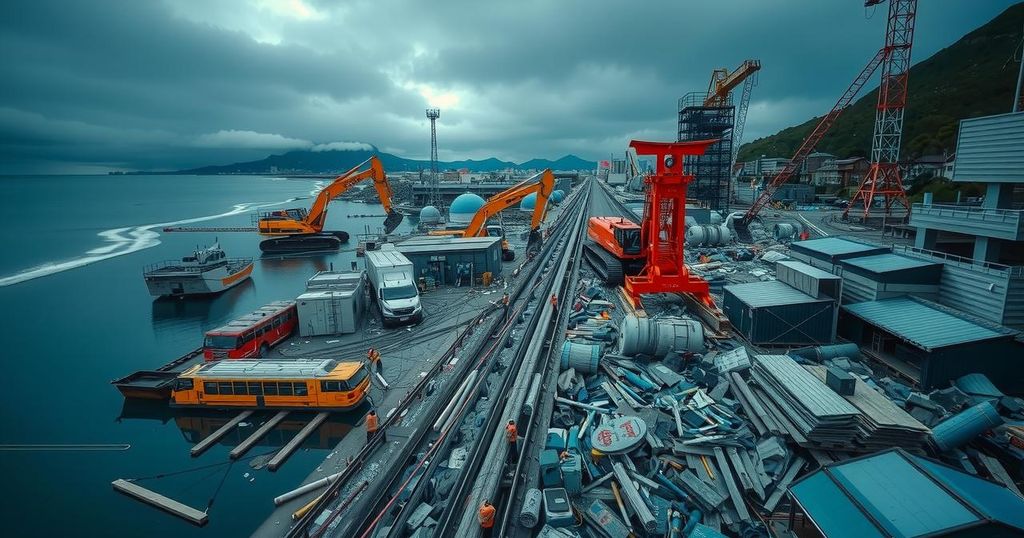Japan’s 2011 Earthquake and Tsunami: Relief and Recovery Efforts

The Tōhoku earthquake and tsunami of March 2011 prompted an extensive and coordinated relief effort in Japan, involving the mobilization of rescue workers and international assistance. Although initial recovery was hindered by severe devastation and nuclear concerns, a comprehensive rebuilding plan led to significant progress in restoring infrastructure and supporting displaced populations over subsequent years.
Following the devastating Tōhoku earthquake and tsunami in March 2011, Japan swiftly initiated a wide-ranging relief and recovery operation. Under Japanese Prime Minister Kan Naoto’s leadership, an emergency command center was established in Tokyo, mobilizing a substantial force of rescue workers and approximately 100,000 members of the Japanese Self-Defense Force to respond to the disaster. Further bolstering their efforts, the Japanese government sought assistance from U.S. military personnel stationed in Japan, leading to the dispatch of a U.S. Navy aircraft carrier to aid in the relief operations. Internationally, nations such as Australia, China, and the United States sent search-and-rescue teams, while various global organizations, including the Red Cross, pledged financial assistance. Despite these efforts, rescue operations faced significant challenges, such as accessing devastated areas and adverse weather conditions, which complicated air operations. As the situation unfolded, rescue teams encountered extensive destruction, characterized by towns and cities swept away or buried under debris, leading to a grim recovery effort focused on locating victims. In the immediate aftermath, a considerable number of individuals found refuge in shelters, struggling with limited supplies. Concurrently, as concerns grew surrounding the nuclear reactors in Fukushima, the number of displaced residents increased, particularly in the quarantine zone. Over time, as temporary accommodations were arranged, many people relocated across Japan. Two years post-disaster, while some still resided in emergency centers, over 300,000 individuals lived in temporary housing units or other alternative arrangements, with a significant population remaining displaced due to ongoing evacuation zones. Rebuilding the affected infrastructure became a priority; transportation services and power supplies were progressively restored, although the situation at Fukushima continued to impact the region’s power stability. The devastation resulted in reduced manufacturing output initially, particularly in high-tech industries and automotive sectors. However, recovery trends began to emerge by mid-2012, with industrial output returning to pre-disaster levels. In response to the needs stemming from the disaster, the Kan and Noda administrations proposed and implemented three supplemental disaster-related budgets, culminating in a total of approximately $155 billion for reconstruction efforts in the Tōhoku region. The Japanese government also established a special Reconstruction Agency to facilitate rebuilding, anticipated to function for ten years. Progress reports indicated nearly complete debris removal and the initiation of infrastructure rebuilding efforts in the affected areas, including the construction of seawalls and elevated sites away from the coast.
The article examines the response to the catastrophic earthquake and tsunami that struck Japan on March 11, 2011. The disaster not only caused immediate loss of life and infrastructure damage but also posed long-term challenges in recovery and rebuilding efforts, particularly regarding the environment surrounding the Fukushima nuclear power plant. The coordinated response involved government, military, and international entities, making it a key study in disaster management and humanitarian assistance.
In conclusion, the response to the 2011 Tōhoku earthquake and tsunami illustrates a multifaceted approach to disaster relief and recovery, marked by swift government action, extensive international support, and significant long-term rebuilding efforts. Despite considerable challenges in access and recovery, substantial progress has been achieved over the years towards restoring the affected regions and aiding displaced individuals. The experience gleaned from this disaster adds valuable insights into emergency preparedness and international cooperation in the face of natural calamities.
Original Source: www.britannica.com






